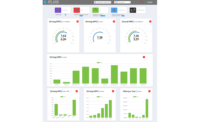How tax changes will impact private fleets in 2018

Like many industries, America’s foodservice corporations with private fleets are ordering units at an increased pace. The latest figures from ACT Research, Columbus, Ind., show that orders for Class-8 trucks surged 62% in October compared with activity from the previous month, and up 167% compared to a year ago.
That’s why it’s critical for food manufacturing and distribution organizations to replace their aging equipment, especially since the American economy continues to rely heavily on truck deliveries and commercial drivers. According to the Bureau of Transportation Statistics, Washington, D.C., more than $1 of every $10 produced in the U.S. GDP can be directly tied back to transport activity. Also, The American Trucking Association, Arlington, Va., indicates that trucks contain 70% of America’s freight (by weight).
That being said, foodservice organizations must be cognizant of 2018 tax changes because the way they procure their equipment can have a significant impact to their overall business, bottom line and financial performance.
What are the impending tax changes?
The tax plan proposed by the current administration contains several provisions that will impact equipment acquisition – lower tax rates for businesses, non-deductibility of interest expense for C corporations, limiting like-kind exchanges to real property and expensing of depreciable assets instead of writing them off over years. While it’s hard to say how much of this ultimately gets implemented, the key is to know how these changes may impact a company’s balance sheet, financial plan and tax strategy.
In terms of what is being proposed, the corporate tax rate would be cut to 20%, and a proposal to allow for immediate write-off for equipment. For example, bonus depreciation is doubled to 100% and companies can write off the full amount of qualifying purchases in the same year of acquisition, which is intended to spur investment. In addition, used equipment will qualify for bonus depreciation for the first time. Organizations can continue to deduct the cost of leased assets and the tax benefits inherent in tax-advantaged leases get passed along to the leasee through lower pricing. Leasees will also enjoy lower tax rates that will help them expand the business.
This is particularly critical for foodservice organizations, as echoed by Mark Allen, president and CEO of the International Foodservice Distributors Association (IFDA), Washington, D.C., and chair of the Coalition for Fair Effective Tax Rates. In a recent statement, he addresses that wholesaler-distributors are currently taxed at an effective tax rate of 37%, which is significantly higher than many other industries.
What’s more, the overall foodservice industry will benefit from tax cuts, particularly since retailers pay the largest income tax rates out of every industry in the United States, according to Matthew Shay, president of the National Retail Federation, Washington, D.C., in a Washington Post article.
The new tax structure is intended to help businesses grow and expand, but much of this savings can also go toward hiring new and retaining existing drivers, since the talent pool is extremely competitive and the driver shortage is becoming more and more visible. An hourly compensation survey conducted by IFDA, in partnership with Paradox Compensation Advisors, Dallas, Texas, found that truck drivers working in the foodservice industry earn an average of $62,854, or 30% more than the average yearly wage than tractor-trailer operators in general. The difference is even more striking when foodservice truck driver pay is compared to average light truck/delivery services driver wages, which is almost 50% higher, according to the trade group’s poll.
Leasing has proven to be a valuable, tax-friendly option for equipment acquisition. In many cases, a lease is still favorable over a loan for acquiring equipment. Under the new U.S. accounting rules, customers with operating leases will find that the capitalized asset cost is lower compared to a loan or cash purchase. Why? Because the balance sheet presentation of an operating lease reflects only the present value of the rents due under the contract as the asset amount, and as a result, is still “partially” off-balance sheet. In addition, since the cost of an operating lease is reported as a straight-line expense of the full lease payment each period, there is no front-end loaded P&L impact that comes from expensing depreciation and imputed interest costs, as there is when a customer borrows to make an outright asset purchase. The P&L impact is different under the international accounting standards (the expenses are front-end loaded), but the result under both standards is that leasing – compared to borrowing to buy – will show a better return on assets (ROA), return on invested capital (ROIC) or return on capital employed (ROCE) for the lessee, which are measures used by many companies and equity analysts.
Moreover, consider the discounted cost and built-in flexibility of financing, which offer additional savings, extended payment options and equipment upgrades or add-ons. Improved cash-flow management, keeping pace with technology and aligning capital asset acquisition strategy with business needs in real time all create economic and practical advantages compared to a loan.
Procurement strategies remain critically important
Foodservice organizations with private fleets must still pay close attention to the way in which they procure new trucks, especially under the changing tax environment. Many organizations have begun to lease more of their trucks, whereby a shorter asset management lifecycle helps reduce costs significantly. Everything from lower fuel costs, maintenance and repair and disposal costs are reduced in a leasing environment, while the residual risk is minimized.
Many of these companies are taking an even closer look at how procurement and certain equipment lease structures impact overall financial performance. Knowing the intricacies of different types of leases (operating vs. capital, for example) can help achieve better key performance financial metrics significantly and allow allocation of funds to other areas of their business.
Whether through economic expansion forthcoming by the proposed tax cuts or a desire to replace aging trucks, more businesses today are focused on truck procurement strategies. Decisions such as lease vs. purchase, the type of lease, as well as changing tax implications can all have consequential effects to an organization’s bottom line.
Looking for a reprint of this article?
From high-res PDFs to custom plaques, order your copy today!





